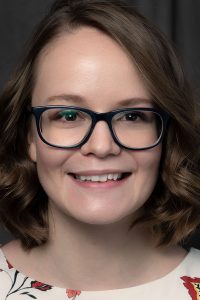Alana Welm always knew she wanted to be a scientist.
“For me,” she said, “[pursuing research] was a straight path.”
Bryan Welm decided he wanted a career in research while in college after volunteering in a breast cancer lab at the University of California, Santa Cruz. The lab was run by one of one of his lecturers, who he said was very passionate.
“First he thought he was going to own a surf shop,” Alana said.
Bryan and Alana are researchers at the University of Utah’s Huntsman Cancer Institute (HCI) and are a married couple. Both work in breast cancer research, each running their own labs that work on separate parts of the disease. Bryan’s lab is primarily focused on therapeutic treatment, trying to find and understand any drugs that might work to treat breast cancer. The focus of Alana’s lab is narrower — it works to understand how breast cancer spreads and what drugs might stop that process.
The two met while pursuing doctorate degrees in cell and molecular biology at the Baylor College of Medicine. Bryan was working in a breast cancer lab that Alana rotated into. Alana said they started dating and were married within a year, so she decided not to join that lab on a more permanent basis. She took a position in another laboratory working on another issue, but said she kept learning about breast cancer “by proxy” through Bryan.
Since then, the Welms have always had to find two jobs in the same place. They did their postdoctoral fellowships at the University of California, San Francisco, in different labs. Bryan said they’ve been lucky, and the process of finding positions together has been easier than they thought it might be. They worried most about finding faculty positions. Alana applied first, he said, then after some places showed interest in her, he applied, too. The couple interviewed together at some institutions. Bryan said they found that some places have an “appreciation for husband-wife teams.” The HCI is one of them.
Mutual Interests
The pair were interested in cancer research for similar reasons. Bryan said the family of diseases is complicated, and they’re constantly learning. Hypotheses change quickly because the overall understanding changes frequently.
“We think down this road and then we realize new data [has come] out that totally changes our thinking,” Bryan said. “It’s definitely not boring.”
For Alana, cancer research is a “giant puzzle.” She explained it’s like “a puzzle you’re trying to do, but the rules change or the shape of the pieces change all the time.” She was “drawn to the mystery of it.”
Although each has their own focus, sometimes they work together in their research. The best example of this, according to Alana, is a grant they recently won from the National Cancer Institute under which the HCI will become one of only four research institutions in the nation working with what’s called a patient-derived model.
“We can’t study humans all the time, but there are a lot of things we can do in the laboratory with cell lines, with mouse models,” Bryan explained.
The patient-derived model is a method of studying cancer samples in which tumor specimens are taken from patients and grown in a laboratory. Sometimes those samples are grown in mice and the mice can be used to understand different aspects of that specific patient’s disease — the growth, the spread and its sensitivity to different treatments.
“Mice are what we’d consider an avatar of that patient,” Bryan said.
“Breast cancer isn’t one disease, it’s probably 20,” Alana said. “But a doctor can’t tell the difference between them. You have to do molecular analysis to understand the difference between them. That’s really the basis for our work. By making these patient-derived models, we can literally make personalized avatars of somebody’s tumor to figure out how it behaves and what might be the best therapy.”
New Developments
The HCI will be the only cancer center using the patient-derived model in breast cancer. The hope isn’t just to help individual patients, but to help the National Cancer Institute, a government agency, decide which drugs should be tested in clinical trials at its facilities.
The grant for the patient-derived work is the first grant the Welms have jointly been awarded. They will supervise the project together.
The biggest impact Alana has seen with the model is discovering one of the processes through which tumors spread to the bone. She worked with pharmaceutical companies to find a drug that would block the action. After a number of years, they found something. It was tested in phase 1a clinical trials in Singapore, and it is slated for phase 1b clinical trials with 16 breast cancer patients at the HCI. She received approval from the U in early October.
Alana feels cancer researchers are starting to see progress.
“[It] gives me hope we’ll make a difference,” she said.
The progress is mostly in other cancers.
A treatment technique called immunotherapy has recently seen significant progress in cancers like melanoma and some lung cancers. It works by enhancing a patient’s immune system and giving it the information to attack cancer cells. Some patients, who likely would have died had they been diagnosed just a few years earlier, have been cured completely.
“[We’re] trying to figure out why that works well in some cases, and why it’s not working well in breast cancer, and how we can make it work better,” Alana said. “[It gives] me a lot of motivation. It’s like seeing the light at the end of the tunnel.”
Cancer research has made big strides since the couple was first being trained in the field.
“The number of techniques we have now and how quickly we can get data is amazing,” Bryan said. “When we were in graduate school, how we determined the genetic code of the cell we were working with or the tissues was very labor intensive, very time-consuming. We ran these massive 3-foot gels and you had to visually look at each little lane and each band to figure out the code, and you could only do maybe 500 bases at a time.”
There are approximately 3 billion bases in a single person’s genetic makeup.
“Now you can do a whole genome of a person in two to three days for a cost of $2,000, $3,000 or so, which is amazing,” he said. “There’s so much information we can get.”
Understanding and Application
Bryan said the amount of data that can be produced now presents new challenges. Today there are questions about how to store it all safely and how to analyze it.
Alana said it takes a lot of time to go from an understanding of how part of cancer works to figuring out drugs that can be used in hospital settings, and all that research is expensive.
Hundreds of billions of dollars have been spent on cancer research since former President Richard Nixon signed the National Cancer Act of 1971. Practically speaking, Alana said, most of that money goes into jobs.
“It’s a combination of investing in the basic science to make the therapy and training the next generation of scientists who are going to work on the next problems,” she said.
Clinical trials are especially expensive in terms of staff. There must be not only doctors and nurses to care for the patients, but also extra staff to coordinate, ensure everything is working under regulation and to report to the Federal Drug Administration. They are there “every time the [patient] sneezes, practically,” according to Alana. All of this is to make sure the patients are safe and verify whether the drugs really work or are dangerous.
Bryan said hiring new researchers is necessary. All of the information that has already been learned has to be transferred to the next generation so they can build upon it.
Common Ground
Alana feels having the same job helps the pair better empathize with each other.
“On one hand it’s hard because we both have really demanding jobs with a lot of pressure, but on the other hand it’s easier because we understand it and we can be flexible,” she said.
That flexibility is especially needed so they can parent their two children.
“A lot of what we do is very abstract, so people don’t understand [if they aren’t in science],” Alana said. “It’s not like you do this, this and this and you’re done. We’re never done with our jobs. Maybe someday we can put ourselves out of business, but there’s always another question. You never really solve something because every answer leads to a new question.”
Bryan agreed, saying, “That understanding aspect is really important. There are times when you have to work constantly on a problem,” and there are projects with hard deadlines that require an incredible amount of work. Alana recently had to create a document for a grant that was over 700 pages long.
“I know how it works with Alana and how she’s going to react, and she knows how it’s going to work with me and how I’m going to react,” Bryan said. “She knows my weaknesses and where she can help me get a grant out the door. She doesn’t have any weaknesses, but if she did I would know those as well and help her. That kind of understanding is what makes this really work.”
The Welm’s children understand how it works, too. They’ve met cancer advocates, survivors and patients in treatment. People they’ve met have died because of cancer.
“They’re exposed to the reality of it and I think they understand it,” Bryan said.
One of the children, in particular, seems interested in science, according to Alana.
“They think about it more than kids typically would. For example, our daughter who is in eighth grade really wants to go see the P!nk concert … and she had this idea, ‘Maybe we can get P!nk to donate to breast cancer research because her name is P!nk.’ What eighth grader would be thinking about how a pop star might want to contribute?” Alana asked. “It must be on her mind because we have to do fundraisers and different things like that.”
e.vandersteen@dailyutahchronicle.com
@EliseAbril



